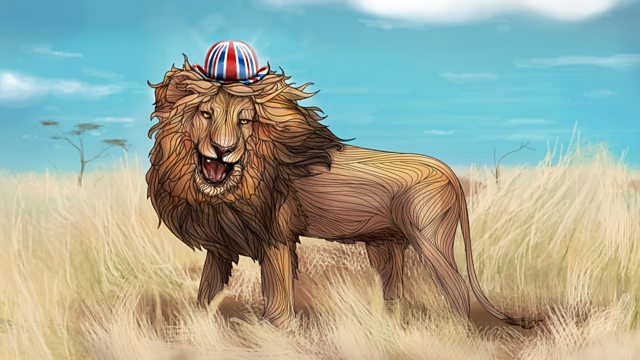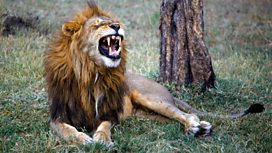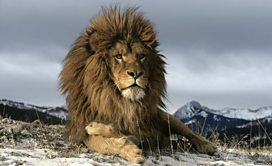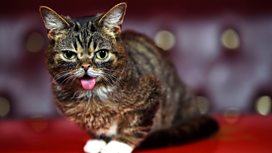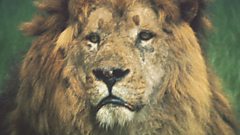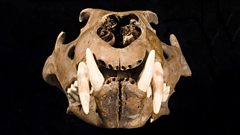Lions
Brett Westwood explores how lions have been harnessed by humans as a symbol of strength from medieval times through to The Lion King.
Brett Westwood explores how lions have been harnessed by humans as a symbol of strength and power throughout the ages.
For hundreds of years two beasts lay beneath the mud of the moat surrounding the Tower of London. Only when workmen dug them up in 1935 did the sun warm their bones once more. They were once kept as fearsome gatekeepers, reminding people visiting the king exactly where power lay - or that was the idea. In reality they were diseased, malnourished and died young.
From the exquisitely depicted lions painted on cave walls in the Palaeolithic through to those kept in the Tower of London and the lions sitting around Nelson's column this programme looks at how we have used lions.
Lions are used in literature to represent authority and majesty, and C S Lewis used a lion - Aslan - to be the figure of Christ, a mysterious, wild presence that cannot be tamed.
However, this attention has come at great cost. Barbary lions, the magnificently-maned North African species most used by the Romans for gladiatorial combat and dispatching Christians, were so over-exploited they are now extinct: the first documented example of mass extinction on the mainland at the hands of humans.
We might be able to breed them back again from lions in zoos that have Barbary genes still present, but should we? Would these magnificent beasts become just a curiosity, no different to those in the Tower? Maybe they had best remain as a poignant example of how power can destroy.
Last on
![]()
From Trafalgar Square to the stars of the zodiac, 11 things to learn about lions.
![]()
Producer Mary Colwell explains how our fascination with lions has caused them harm.
![]()
Pussy Galore
Susan Calman finds out why our feline overlords rule cyberspace.
Clips
-
![]()
The World According to Lion
Duration: 01:16
-
![]()
Symbolism of the Lion of Judah
Duration: 05:19
-
![]()
How bad diet affected the Tower of London lions
Duration: 00:57
-
![]()
How it feels when a male lion roars nearby
Duration: 00:49
Richard Sabin

He is special advisor to the NHM鈥檚聽, carries out endangered species identification work for UK and international law enforcement, and develops internationally recognised protocols and techniques for the extraction of genetic material from the Museum's research specimens.
Rosie Broadley

She specialises in the relationship between written life-stories and visual portraits and her research interests include portraits of 19th and 20th century female suffragists, including the portrait of , British Academic portrait painters working between 1900 and 1939, and the interactive nature of contemporary portraits.
Adam Chapman

He joined Silverback films where he directed a Disney Nature feature film called and is now working on Netflix's latest commission.
Sally Dixon-Smith
She works with the archaeological collections and curates new displays, such as the representation of the Crown Jewels in 2012 and the centenary of the First World War in 2014. With training in history and architectural history, she is particularly interested in social history and how people used buildings.
Dr Paul Fox

Professor Erica Fudge

Her work has also appeared in聽聽magazine. She is the director of the聽.
Jonathan Andrew Hume

His film credits have included Bluff, Filthy Habit and Decorating. He was a session singer for the motion pictures 10,000 BC, Amazing Grace and Pride.
Tom Kerss

Anthony Lynn
He has directed top Broadway shows and overseen tours of productions such as聽Mary Poppins the recent Les Mis茅rables 25th anniversary productions in Toronto and across the USA.
Professor Ralph Pite
He is currently writing a book about the poets, Robert Frost and Edward Thomas. They were close friends in the three years before Thomas鈥檚 death in 1917, at the Battle of Arras. Both men shared a love of nature and an interest in 鈥榯he simple life鈥� 鈥� in ways of living, which we would call sustainable.
Broadcasts
- Tue 30 Jun 2015 11:00麻豆官网首页入口 Radio 4
- Mon 6 Jul 2015 21:00麻豆官网首页入口 Radio 4
